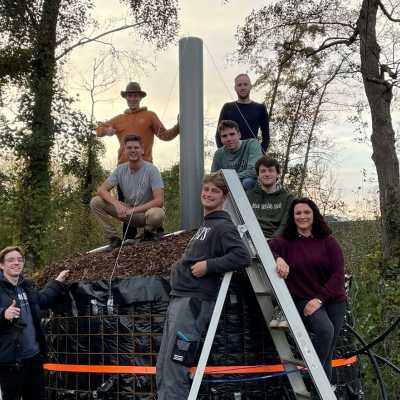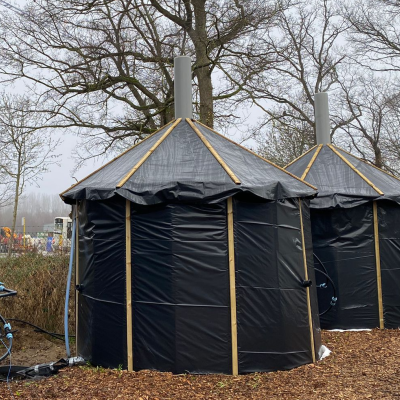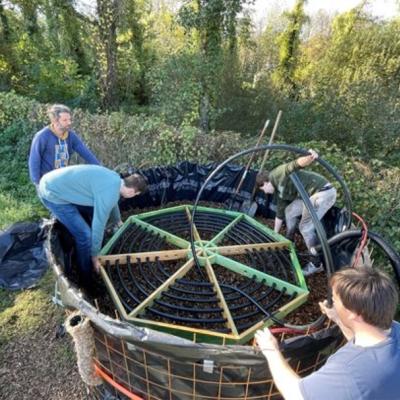CLOSECYCLE is aiming to be a platform for upgrading organic residual waste streams to useful end products. Within the project territorial biorefinery networks (TBN) are formed around the cascading of local residual wastestreams. A lot of experience and information is coming from the activities of the partners in de project. But CLOSECYCLE is, together with companies and experts outside the project, also organizing PopUp Talks from which more can be learned. For these PopUp talks all contacts and subscribers of the CLOSECYCLE newsletter are invited. Last week Evert Vanecht of the UCLL (the University of Applied Sciences in Leuven) and Irma Corten of Stichting Biomeiler, explained the system of the Biomeilers. And their experiences with this closed system, in which the combination of composting and heat generation is the objective.
Layers with woodchips and tubes
In the system, layers of woodchips are followed by a layer of plastic tubes in which the water will be pumped around. The UCLL tried different woodchips (fresh and old woodchips) and adding extra materials like horse manure and apple pomace. For obtaining the most optimal composting process, and reaching the right high temperature, the combination of fresh chopped wood and horse manure plus apple pomace was the best. These Biomeilers reached temperatures of 50-60 °C. After the system of layers is build up, the outside of the pile is isolated. In the pile aeration is done by adding a chimney.
Heat generation
With the right material and aeration, the Biomeiler can keep the high temperatures during a longer period. Sometimes months till years. By pumping water through the tubes, the heat will be extracted. It is clear that there are multiple factors that influence the effectivity of the Biomeiler. Evert and Irma explained these factors:
- Starting material of the piles. Fresh or older woodchips; wood chips are used to become air within this static composting pile. There was also some experience with storing woodchips, which were pre-digested before composting. All influencing the composting process.
- Moment of starting up the Biomeiler; in winter reaching the right temperatures takes much longer;
- Using cold water as starting the composting process is not a good idea; the micro-organisms, responsible for the composting process, need some warmth to do their job.
- Inside the pile there could be a optimal composting process, while at the outside of the piles, the temperature can be much lower.
Irma Corten explained the new project Teapots, in which a broad spectrum of factors will be measured the coming two years. By extensively measuring and monitoring, it will be clear how to reach the most optimal system of the Biomeiler. And both gaining a good quality compost and heat generation.
Quality of the compost
Evert Vanecht and his students measured also different compost characteristics. And made a comparison with green commercial compost. Characteristics like pH, nutrients and nitrogen content are comparable with the green compost. Especially the waterholding capacity and organic matter content of the compost from the Biomeiler is much better.
Looking at the micro-organisms, there are much more favourable fungi, protozoa and nematodes in the Biomeiler compost, compared to the commercial green compost. For using these interesting end product improvement of soil heath can be expected.
This summer, Viaverda will use the compost from the Biomeiler as a peat substitute in a test with strawberry.
Future of Biomeiler
In the meeting Evert Vanecht explained that the Biomeiler is especially a good solution for farmers, who have the ambition to make their own compost and generate heat. Also from the point of view of legislation and composting. For good compost, compost piles have to be turned over during composting. In case of the Biomeiler, there is a static composting pile, which can not be turned around.
The earlier called Teapots project, will give more insights in the system and the characteristics. And possibly results also in a monitoring and prediction system. By measuring temperatures, moisture, etc in the piles, also the pumping system of the water and aeration can be programmed. One of the objectives of the Teapots project is also the development of a Digital Platform.
The CLOSECYCLE team will follow these nice developments.



